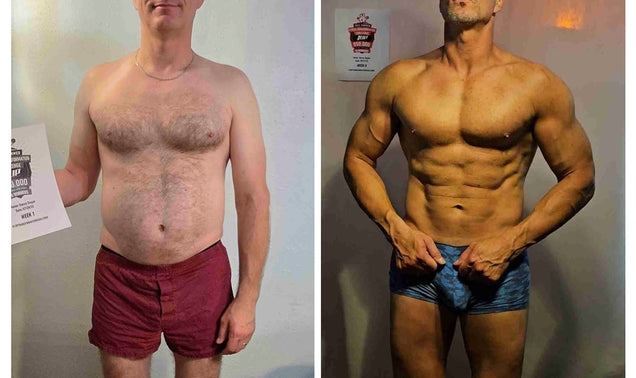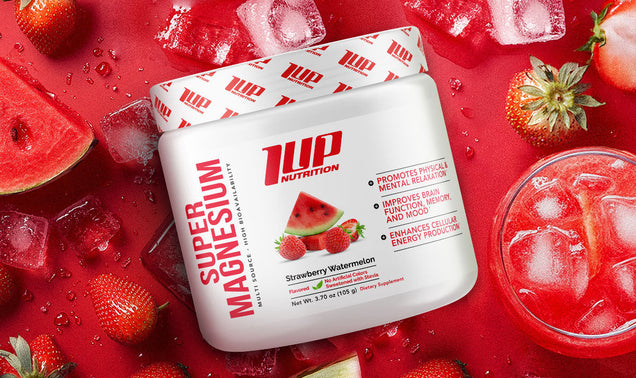Fat loss is a common goal for many individuals who enter our quarterly transformation challenges, and many have experienced life-changing results.
But, a common question on the minds of many folks is “where does fat go when you lose weight?”
Let’s find out!
How Fat Loss Works
When you consume too many calories, your body stores the excess energy in fat cells in the form of triglycerides.
To burn off this excess energy, you need to force your body to use the extra stored calories. This is most efficiently accomplished by creating an energy deficit whereby you burn more calories per day than you consume.[1]
Typically, an individual needs to consume between 10-15% fewer calories below their maintenance calories to force their body to turn to its fat stores and promote weight loss.
By consistently staying in this negative energy balance (i.e. calorie deficit), the body will continue to release stored fatty acids from its fat cells into the bloodstream, where they can be picked up by L-Carnitine and then transported into the mitochondria where they’ll be broken down and used to produce ATP (energy).
Essentially, when you lose weight, the fat is used to produce energy that you’re not consuming through the diet. So, in a sense, the fat is quite literally “burned off.”
More on Where Fat Goes When You Lose Weight
As we mentioned, when you are in a calorie deficit, you are not consuming enough calories during the day to meet the energy requirements of your body. To make up for this deficit, the body turns to its energy stores (body fat).
But, fat cells aren’t just made of triglycerides. They contain other substances as well, including water.
Now, when your body initiates lipolysis (the process by which fatty acids are mobilized and released into the bloodstream to be oxidized -- burned -- for energy), there are two major byproducts released besides triglycerides, namely carbon dioxide (CO2) and water (H2O).
The carbon dioxide is exhaled during respiration (breathing), and the water is eliminated through sweat, urine, or exhaled air.
It’s also worth mentioning that removal of excess carbon dioxide and water is considerably ramped up during intense exercise due to the increased breathing and sweating.[2,3]
Where Do I Lose Fat First?
In an ideal world, we’d lose fat from the quintessential “trouble areas” -- thighs, hips, love handles, lower abs.
Unfortunately, not everyone is blessed with elite genetics, hence the term “stubborn body fat.”
Fat loss is a global process, and genetics do play a fairly prominent role in regards to where your own body will lose fat first.[4]
All of this is to say that we don’t have much of a say which area of our bodies start to lose fat first.
Besides, spot-reduction has largely been debunked and shown to not be very effective.
One thing to keep in mind though is that if you diet for long enough, even those stubborn areas will go away. It’s just a matter of consistency and, even more so, patience.
That being said, certain supplements may help promote the elimination of stubborn body fat. One of the most well-known weight loss supplements for stubborn fat is yohimbineand its chemical cousin alpha-yohimbine (rauwolscine), which can be found in our top-of-the-line men’s and women’s fat burners Pro Ripped Max and Make Her Lean Max, respectively.
Why Is It So Hard to Maintain Fat Loss Results?
Dive into the weight loss literature and you’ll see that thousands (more likely, millions) of individuals are able to lose weight. And, there’s not just one way to lose weight either.
It’s possible to lose weight following low-carb diets, higher carb diets, omnivorous diets, or plant-based diets.
The real challenge isn’t in losing weight. It’s in keeping it off over the long term.
Researchers have identified some common traits among those individuals who are the most successful at losing weight and maintaining their weight loss results. Namely, they maintain high levels of physical activity, track their nutrition, and consistently weigh themselves during the week.
How Long Will It Take Me to Lose Weight?
The answer to this question will vary from one person to another.
One of the biggest (and most important) variables in this equation is how much fat you have to lose. An individual who only has to lose 10 pounds will reach their end goal quicker (typically) than someone who has to lose 25 or 30 pounds.
Another key consideration is how consistent are you with your diet and exercise plan, meaning how strict are you with following your nutrition plan. If you are cheating on your diet frequently, you’re delaying your results.
Still another factor is how large of a deficit you adopt during your transformation challenge. The larger energy deficit you create, the quicker you will lose fat (to a certain extent). Using too large of a calorie deficit can lead to feelings of extreme hunger (increasing the likelihood you’ll ditch your diet and binge) as well as muscle loss.
Other notable side effects of being too aggressive with calorie cutting are headaches, dizziness, irritability, micronutrient deficiency, and menstruation irregularities.[5]
This is why the preferred course of weight loss is to take the slow and steady approach. You’ll find being more moderate with your energy deficit (10-20% below maintenance) is more sustainable and you’ll greatly limit the potential for muscle loss.
Types of Body Fat
You might be surprised to find out that not all body fat is the same. In fact, there are two (three) different types of body fat.
White Fat
White fat constitutes the majority of fat on our bodies. Its primary purpose is to serve as a repository for excess energy that can be accessed during times of low calorie intake (i.e. dieting).
White fat can be further subdivided into two categories:
Subcutaneous Fat
As the name implies, subcutaneous fat lies just beneath the skin. It’s the kind of fat you can pinch, and it’s the type of fat most of us focus on losing -- muffin tops, love handles, etc.
Excessive subcutaneous fat can put stress on the joints, low back, and cardiovascular system.
Visceral Fat
Visceral fat is the other type of white fat, but it’s not the kind you can pinch. Visceral fat is the type of fat that is found deep within the abdominal cavity and surrounds organs like the liver, pancreas, and kidneys.
Accumulation of visceral fat is known to impair organ function and lead to a host of health complications, including inflammation, insulin resistance, and the increased risk of several chronic diseases.
Brown Fat
Brown fat is more metabolically active than white fat.
Whereas white fat serves as a placeholder for excess energy, brown fat serves as a type of “good fat” that breaks down blood sugar (glucose) and fat molecules to generate heat and help maintain body temperature.[6]
Infants and newborns typically have more brown fat stores than full-grown adults, but research has shown that exposure to cold temperatures as well as certain supplements (such as Paradoxine, which is found in 1UP men’s and women’s fat burners Pro Ripped Max and Make Her Lean Max) can increase brown fat activation in the body.[7,8]
Takeaway
Losing weight requires consistency, diligence, and patience.
Using a combination of diet, exercise and proper supplementation will help shrink fat cells over time as the fatty acids stored within them will be used for energy, ultimately leading to better body composition and health.
References
-
Howell S, Kones R. "Calories in, calories out" and macronutrient intake: the hope, hype, and science of calories. Am J Physiol Endocrinol Metab. 2017 Nov 1;313(5):E608-E612. doi: 10.1152/ajpendo.00156.2017. Epub 2017 Aug 1. PMID: 28765272.
-
Baker LB. Sweating Rate and Sweat Sodium Concentration in Athletes: A Review of Methodology and Intra/Interindividual Variability. Sports Med. 2017;47(Suppl 1):111-128. doi:10.1007/s40279-017-0691-5
-
Aliverti A. The respiratory muscles during exercise. Breathe (Sheff). 2016;12(2):165-168. doi:10.1183/20734735.008116
-
Singh P, Somers VK, Romero-Corral A, et al. Effects of weight gain and weight loss on regional fat distribution. Am J Clin Nutr. 2012;96(2):229-233. doi:10.3945/ajcn.111.033829
-
Christensen P, Bliddal H, Riecke BF, Leeds AR, Astrup A, Christensen R. Comparison of a low-energy diet and a very low-energy diet in sedentary obese individuals: a pragmatic randomized controlled trial. Clin Obes. 2011 Feb;1(1):31-40. doi: 10.1111/j.1758-8111.2011.00006.x. PMID: 25586973.
-
How Brown fat improves metabolism. (2019, September 17). National Institutes of Health (NIH). https://www.nih.gov/news-events/nih-research-matters/how-brown-fat-improves-metabolism
-
Sugita, J., Yoneshiro, T., et al; “Grains of paradise (Aframomum melegueta) extract activates brown adipose tissue and increases whole-body energy expenditure in men”; British Journal of Nutrition; (2013) 110(4), pp. 733–738; https://www.cambridge.org/core/journals/british-journal-of-nutrition/article/grains-of-paradise-aframomum-melegueta-extract-activates-brown-adipose-tissue-and-increases-whole-body-energy-expenditure-in-men/517F8F0D73864C919E42D502537BA01D/core-reader
-
Sugita J, Yoneshiro T, et al; “Daily ingestion of grains of paradise (Aframomum melegueta) extract increases whole-body energy expenditure and decreases visceral fat in humans”; Journal of Nutritional Science and Vitaminology; 2014, 60(1): 22-27; https://www.jstage.jst.go.jp/article/jnsv/60/1/60_22/_pdf






